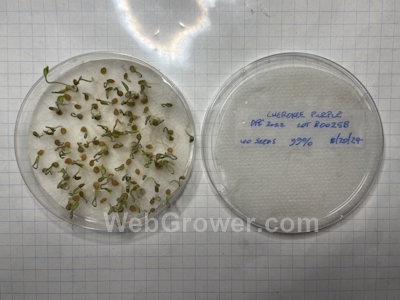Homepage → Seed Related Topics → Simple Seed Germination Test
Simple Seed Germination Test
Planted June 17, 2013
Last tended to on October 11, 2024
Reading time: 4 minutes

by Mike Dunton
Planting seeds is said to be an act of faith. In Henry David Thoreau’s work, “Faith In A Seed,” he states, “Though I do not believe a plant will spring up where no seed has been, I have great faith in a seed. Convince me that you have a seed there, and I am prepared to expect wonders.”
Although raising food requires some faith – faith that the weather will behave, faith that the sun will shine, and faith that disease or infestations will not find your garden – your seeds don’t have to be an unknown variable. By knowing the actual quality of your seed supply, you improve your odds for a bountiful harvest.
Depending on the species of seed, and as long as they have been properly stored, they can remain viable for many years. It is important to know that the seeds that you are about to sow are healthy and strong. If you have reason to suspect your seed, taking the time to do a simple germination test can be time well spent.
For each test, you will need:
- Paper towels
- Sealable plastic bags or petri dishes
- An indelible marking pen
- A notebook for recording information
Procedure:
- Moisten a paper towel. The goal is to reach its saturation point. Wet but not dripping. Using a misting spray bottle is useful.
- Choose a sampling of seeds representative to the whole lot you are testing. That is, do not select all the best looking seeds or your results will be skewed. Additionally, the more seeds that you can spare to do the test, the more accurate your result average will be. Ten seeds should be considered an absolute minimum.
- Although not absolutely necessary, rinsing the seeds in a bleach solution (1 part beach to 10 parts water) will help prevent fungal and/or bacterial growth during your test. Again, this is not usually necessary.
- Place seeds to be tested on one half of the damp paper towel and fold the other half over the seeds.
- Place the towel with the seeds into a plastic bag and partially close the bag. Using the marking pen, write the variety name of the seed, the date you are starting and the number of seeds onto the bag. Also write this information into your notebook. Alternately, you can use petri dishes, instead of plastic bags, for testing small seeds. These dishes can be washed and re-used for many years.
- Keep the bag (or petri dish) in a warm, dark place. A kitchen cupboard on an inside wall is a good place.
- On a daily basis, remove the towel and check on the results. Keep it evenly moist and note seed progress. Seed germination times vary by type and temperature. Click here for some general guidelines.
- After several days, your seeds should begin germinating. If a seed molds or looks rotten, count it as dead and discard it. If it looks like it is growing into a plant, count it as good and discard it. In your notebook, keep a running count of the good and bad seeds.
- Refold the towel, place it back into the bag and check again. At the end of an acceptable amount of time (10 to 14 days), or if all of the seeds have germinated, count the total number of good seeds. If all of the seeds germinated, then you have a perfect germination rate - 100%. If it was less that perfect then divide the number of seeds that germinated by the number you started with and you will determine the % germination rate. For example, if you started with ten seeds and only nine germinated, then 9/10 germinated, which equals 0.9 or stated as a percentage, 90%.
- If the germination rate is low but the seeds are still vigorous, you can go ahead and plant them. It just means that you need to sow extra seeds to get a good stand. For example, if the germination rate is 50%, sow twice as much seed. However, if the seeds are slow to germinate (low vigor), on top of a low germination rate, it is probably best to purchase fresh seed.
One note from personal experience, you do not have to throw away your tested seeds. If you are careful not to damage the sprouted, tiny seedlings, go ahead and plant them.
Mike Dunton is an "heirloom seed pioneer" who founded, and is the former owner of, the Victory Seed Company. As a seed professional, biodiversity preservationist, horticultural historian, technologist, farmer, gardener, homesteader, writer, and educator, he has worked for decades to share the knowledge and experience that he has gained over a lifetime of trial and error. He strives to pass down his passion for incorporating old-timey skills into our everyday, modern lives.
Copyright © 1998 - 2024 - All rights reserved
WebGrower.com℠ is a service mark of Victory Horticultural Group, LLC.
• Privacy Statement •
This site participates in the Amazon Services LLC Associates Program, an affiliate advertising program designed to provide a means for sites to earn advertising fees by advertising and linking to amazon.com.